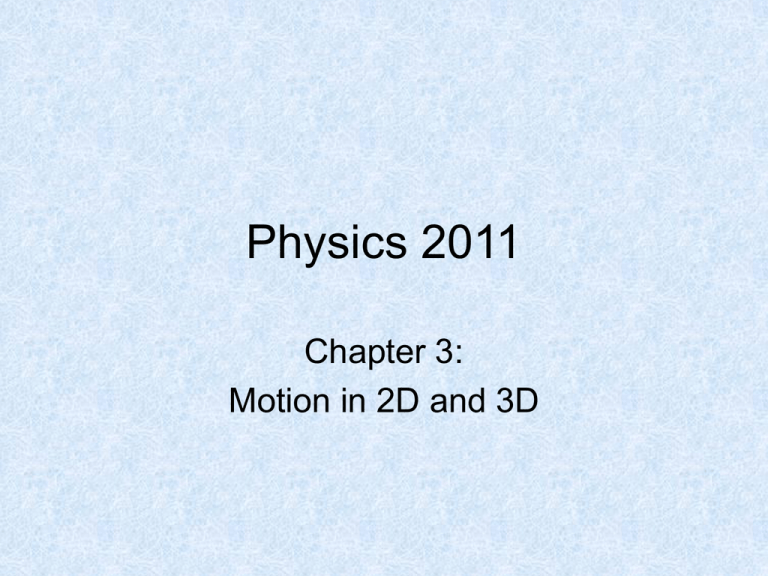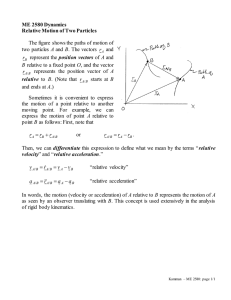Physics 2011 Chapter 3: Motion in 2D and 3D
advertisement

Physics 2011 Chapter 3: Motion in 2D and 3D Describing Position in 3-Space • A vector is used to establish the position of a particle of interest. • The position vector, r, locates the particle at some point in time. Average Velocity in 3-D • Vavg = (ř2 – ř1)/(t2-t1) = Δř / Δt • Δt is scalar so, V vector parallel to ř vector Instantaneous Velocity • V’ = lim (Δř / Δt) as Δt 0 = dř / dt • 3 Components : V’x = dx / dt, etc • Magnitude, |V’| = SQRT( Vx^2 + Vy ^2 + Vz^2) Average Acceleration • âavg = (v’2 – v’1)/(t2-t1) = Δv’ / Δt • â vector parallel to Δv’ vector Instantaneous Acceleration • â = lim (Δv’ / Δt) as Δt 0 = dv’/ dt • Has the 3 components: âx = d vx/ dt, etc • These components could also be written with respect to position vector: âx = d2x / dt2, etc Parallel and Perpendicular Components of Acceleration Acceleration on Curve • Different for a) constant speed, b) increasing speed, c) decreasing speed Projectile Motion • Free Fall Problems in 2D or 3D are “Projectile Motion” problems • Projectile path is called a Trajectory Acceleration during Projectile Motion • The a vector is constant (g, gravity) and downward all along the projectile path 2D path, Acceleration Vector Equations for PM Uniform Circular Motion What defines UCM? • Constant SPEED (not velocity!) • Constant Radius (R = c) y V (x,y) R x UCM using Polar Coordinates • The polar coordinate Cartesian: Polar: system (magnitude and angle) is a natural way of Position: x, y Position: R, θ describing UCM, where R and speed are Velocity: Velocity: constant: Vx = dx/dt, dR/dt, dθ/dt Vy = dy/dt (let ω=dθ/dt) Vx,Vy always dR/dt =0 changing dθ/dt=ω=constant Velocity in Polar Form: • Displacement is an Arc, S, of the Circle • Displacement s = vt (like x = vt + xo) but s = R = Rt, so: v = ωR Average Acceleration in UCM: • Average Acceleration, aavg = ΔV/Δt • The Δ V vector points toward origin Instantanous Acceleration in UCM • This is called Centripetal Acceleration. • Like triangles, ΔR and ΔV: Thus: v R v R But R = vt for small t v vt So: v R a = V2/R v v 2 t R Relative Motion • First thing: A Frame of Reference • Since Einstein, a distinction has to be made between references that behave classically and those that allow Relativity • Classical frames of reference are called Intertial Inertial Frames of Reference: • A Reference Frame is the place you measure from. – It allows you to nail down your (x,y,z) axes • An Inertial Reference Frame (IRF) is one that is not accelerating. – We will consider only IRFs in this course. Stationary or constant velocity • Valid IRFs can have fixed velocities with respect to each other. – More about this later when we discuss forces. – For now, just remember that we can make measurements from different vantage points. Consider the Frames in Relative Motion: • A plane flies due south from Duluth to MPLS at 100 m/s in a 15 m/s crosswind:


